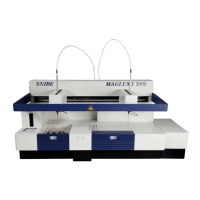INTENDED USE
The kit has been designed for the quantitative determination of
Aldosterone (ALD) in human serum or plasma.
The method can be used for samples over the range of 5-1000
pg/ml.
The test has to be performed on the Fully-auto
chemiluminescence immunoassay (CLIA) analyzer MAGLUMI
(Including Maglumi 600,Maglumi 1000,Maglumi 1000 Plus,
Maglumi 2000,Maglumi 2000 Plus,Maglumi 3000 and Maglumi
4000).
SUMMARY AND EXPLANATION OF THE TEST
Aldosterone (ALD) is a steroid hormone produced by the adrenal
cortex, which controls salt and water balance in the kidney.
Abnormally high levels of this hormone cause sodium retention,
high blood pressure, heart rhythm irregularities and possibly
paralysis. Normally, aldosterone is mediated by renin-angiotensin
system. Moreover, sodium and potassium level, ACTH, adrenal
glands and dopamine also regulate the secretion of aldosterone.
Human blood aldosterone mainly bounds to plasma albumin,
seldom bounds to CBG. Therefore, aldosterone has a relatively
short half life (35min) and higher metabolized clearance. The
non-metabolized aldosterone in human urine accounts for 6% of
the secretion amount and contains hormone activity. The
determination of aldosterone in human plasma or urine is of great
value for diagnosis and identification of some disease.
PRINCIPLE OF THE TEST
Competitive immunoluminometric assay;
Use a purified ALD antigen to label FITC, and use an anti-ALD
monoclonal antibody to label ABEI. Sample, Calibrator or Control,
with ABEI Label, FITC Label, and magnetic microbeads coated
with anti-FITC are mixed thoroughly and incubated at 37℃,
forming antibody-antigen complexes; after sediment in a
magnetic field, decant the supernatant, then cycle washing for 1
time. Subsequently, the starter reagents are added and a flash
chemiluminescent reaction is initiated. The light signal is
measured by a photomultiplier as RLU within 3 seconds and is
proportional to the concentration of ALD present in samples.
KIT COMPONENTS
Material Supplies

